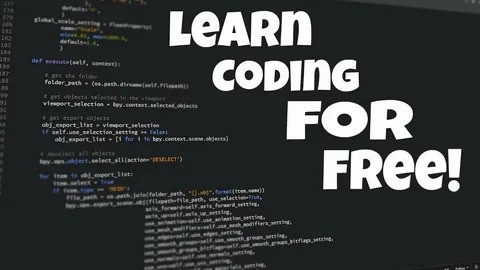How to Learn Coding for Free
Let’s cut through the noise: there are hundreds of sites claiming to teach you coding for free—but only a few are actually worth your time.
In 2025, learning to code is still one of the most profitable decisions you can make. Whether you want to become a software developer, launch your own tech startup, land a remote job, or build a freelance career, coding opens doors.
But do you need a $15,000 bootcamp or a CS degree to get started? Hell no.
Here’s your no-BS list of the top free platforms that actually deliver results—along with tips on what to learn, and how to stay consistent.
🔥 TL;DR — Best Free Coding Sites by Category
| Site | Best For | Why It Stands Out |
|---|---|---|
| freeCodeCamp | Full-stack web dev | Real projects, huge community |
| The Odin Project | Serious career prep | No fluff, Git & backend included |
| CS50 by Harvard | Computer Science basics | Ivy League teaching, free |
| Coursera | Flexible specializations | Real university-level content |
| Scrimba | Interactive front-end | Code along visually |
| W3Schools | HTML/CSS/JS basics | Beginner-friendly & fast |
| MIT OpenCourseWare | Hardcore learners | Actual MIT lectures for free |
| EdX | Data science, Python | Harvard, MIT, IBM-backed courses |
🧑💻 1. freeCodeCamp
🔗 https://www.freecodecamp.org
Why it works:
-
Over 8,000,000 learners worldwide
-
100% free. No trial, no upsells
-
Project-based certification paths
-
Covers HTML, CSS, JavaScript, Python, React, APIs, SQL, D3.js, and more
Best for:
People who want to build real projects and get job-ready without paying a cent.
🔧 2. The Odin Project
🔗 https://www.theodinproject.com
Why it works:
-
Focus on real-world dev tools like Git, GitHub, Linux
-
Project-driven: Build a portfolio as you go
-
Teaches you how to think like a developer
Best for:
People serious about becoming professional developers.
💡 Job-path hack: Pair it with freelancing on Upwork or Fiverr as you go. You’ll already have portfolio pieces to show.
🎓 3. Harvard’s CS50
Why it works:
-
Real Harvard course—available for free
-
Covers C, Python, SQL, data structures, and computer science theory
-
Taught by David Malan, one of the best CS instructors alive
Best for:
People who want to understand how computers and software really work, not just how to copy-paste code.
💡 Pro Tip: This one is tough. Combine with an easier course if you’re brand new.
📚 4. Coursera (Audit Mode)
Why it works:
-
Learn from Google, IBM, Stanford, Duke, and more
-
You can audit (learn for free) most courses
-
Get premium courses without the premium price
Best for:
Structured learners who want guidance from top institutions.
Courses to start with:
-
Programming for Everybody (Python) – Univ. of Michigan
-
Web Design for Everybody – Univ. of Michigan
-
Google IT Automation with Python
👨🏫 5. Scrimba
Why it works:
-
Unique interactive video format—you can pause and code right in the video
-
Great for visual learners
-
Free tracks: Front-end dev, JavaScript, React
Best for:
Anyone tired of passive tutorials and wants hands-on experience from Day 1.
💡 Pro Tip: Their “Learn JavaScript for free” course is gold for beginners.
🌐 6. W3Schools
Why it works:
-
Fast, clean, straight to the point
-
Learn HTML, CSS, JavaScript, SQL, Python
-
Interactive “Try It Yourself” code editor
Best for:
Absolute beginners who want no-frills coding tutorials they can finish quickly.
💡 Use Case: Great for refreshing syntax or brushing up for technical interviews.
🧠 7. MIT OpenCourseWare
Why it works:
-
MIT’s actual course content
-
Watch recorded lectures, download assignments
-
Completely open and free
Top Picks:
-
Intro to Computer Science & Programming in Python
-
Software Construction
-
Artificial Intelligence
Best for:
People who want to go deep into theory and maybe explore AI, algorithms, or systems design.
💡 Heads up: It’s not beginner-friendly unless you’re self-motivated and don’t need hand-holding.
📊 8. edX (Audit Mode)
Why it works:
-
Learn from top universities & tech giants
-
Audit mode = free learning (no certificate)
-
Excellent Python, data science, and software engineering content
Best for:
Intermediate learners, or anyone focused on data science, ML, or Python-based development.
💡 Top courses:
-
Python for Data Science (IBM)
-
CS50x (Harvard again)
-
Introduction to Computer Science (MIT)
✅ What Programming Language Should You Start With?
| Goal | Language | Why |
|---|---|---|
| Web development | HTML, CSS, JavaScript | Foundation for all websites |
| Automation / scripting | Python | Simple, powerful, beginner-friendly |
| Data analysis / AI | Python, SQL | Industry standard |
| Game dev | C#, Unity | Cross-platform support |
| Mobile apps | Java/Kotlin (Android), Swift (iOS) | Native development |
| Backend dev | JavaScript (Node.js), Python, PHP | Server-side logic |
If you’re unsure: Start with HTML → CSS → JavaScript or Python.
🧩 Combine & Conquer: Learning Strategy
-
Choose one site from above.
-
Stick to one language for the first 4–6 weeks.
-
Do one small project per week (landing page, calculator, API fetcher, etc.).
-
Use GitHub to document your progress (this is your portfolio).
-
After 60–90 days, start freelancing, building your own tools, or applying for internships.
Learning to Code Isn’t the Hard Part
Consistency is.
The internet has removed almost all the cost barriers. If you can stay consistent for 90 days—even just 1 hour a day—you can go from zero to building your own apps or landing freelance gigs.
The skills you build in public (via GitHub, LinkedIn, or portfolio sites) compound over time.



